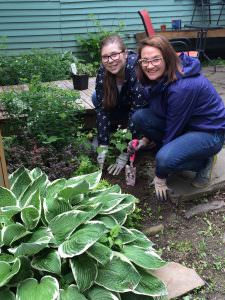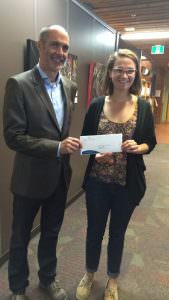 Did you know that pollinators contribute to every one of three bites of food we take!?
Did you know that pollinators contribute to every one of three bites of food we take!?
Pollinators are the insects and birds that transfer pollen from plant to plant. Without these important critters we would not enjoy many New Brunswick crops like apples, blueberries, cranberries, carrots, and broccoli. There are many types of pollinators here in New Brunswick, including honeybees, bumblebees, flies, moths, butterflies, beetles and the ruby-throated hummingbird!
Unfortunately, New Brunswick’s pollinator population has been decreasing drastically in recent years because of decline in habitat, use of pesticides, disease, parasites and climate change.
Individuals can make a big difference by planting pollinator gardens with native New Brunswick species. We’re doing our part here at the Conserver House, and you can too.
Last week, Karyn, Olivia and Ainslee were able to re-plant our native pollinator garden outside the Conserver House in Fredericton. They planted some veronica, bee balm, black-eyed susans and Canadian violets!
These native pollinator friendly plants will keep our garden buzzing.
A visit to David Smith’s ‘Save a Nature Plant’ Nursery: Getting Started.
A visit to David Smith’s ‘Save a Native Plant’ Nursery: Putting it all together.
 This project would not be possible without our generous donors at the Fredericton Community Foundation (FCC). The FCC recently donated than $2,000 to be used to develop and organize public pollinator workshops.
This project would not be possible without our generous donors at the Fredericton Community Foundation (FCC). The FCC recently donated than $2,000 to be used to develop and organize public pollinator workshops.
Pollinators play an important role in New Brunswick’s natural ecosystem, but they are also commercially vital to the Province’s fruit and vegetable producers. These workshops are designed to help people identify ways they can make an individual and meaningful contribution to a greener planet.
Last year our pollinator garden attracted a variety of critters like bees, hummingbirds, butterflies, moths, and other insects crucial to a balanced ecosystem in New Brunswick.
Different insects and birds are attracted to different colors and when a pollinator lands on a plant, they move pollen from one flower to another, fertilizing the plant and allowing it to continue to grow.
